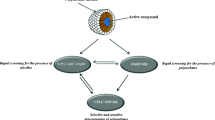Abstract
As a new approach to rapid small-molecule analysis, surfactant-mediated matrix-assisted laser desorption/ionization time-of-flight mass spectrometry (MALDI–TOF-MS) was successfully used in the analysis of caffeine and the vitamins riboflavin, nicotinamide, and pyridoxine in various energy drinks. Of five common MALDI matrices tested (α-cyano-4-hydroxycinnamic acid, sinapinic acid, 2,5-dihydroxybenzoic acid, dithranol, and 2′,4′,6′-trihydroxyacetophenone), α-cyano-4-hydroxycinnamic acid was found to be most suitable for analysis of high-sugar-containing energy drinks. Cetyltrimethylammonium bromide (CTAB) surfactant was used as a matrix-ion suppressor, at a matrix:surfactant mole ratio of approximately 500:1. The resulting mass spectra show very few matrix-related ions, while analyte signals were clearly observed. For comparative purposes the same analytes were identified and quantified in energy drinks by LC–ESI–MS with UV detection. Quantitatively the calibration curves of all four analytes showed a marked improvement when the surfactant-mediated method was used compared with traditional MALDI–TOF-MS; correlation coefficients of 0.989 (nicotinamide), 0.991 (pyridoxine), 0.983(caffeine) and 0.987 (riboflavin) were obtained. It was found that in quantitation of the energy drink analytes the surfactant-mediated MALDI–TOF-MS results were comparable with those from LC analysis. In reproducibility experiments RSD values ranged from 9.7 to 18.1%. The work has demonstrated that this mass spectrometric approach can be used as a rapid screening technique for fortified drinks.





Similar content being viewed by others
References
Aranda M, Morlock G (2006) J Chromatogr A 1131:253
Chen Z, Chen B, Yao S (2006) Anal Chim Acta 569:169
Luo X, Chen B, Ding L, Tang F, Yao S (2006) Anal Chim Acta 562:185
Pena A, Lino C, Silveira M (2005) Food Addit Contam 22:91
Aresta A, Palmisano F, Zambonin C (2005) Food Chem 93:177
Thomas J, Yen JH, Schantz MM, Porter B, Sharpless KE (2004) J Agric Food Chem 52:3259
Bispo M, Veloso M, Pinheiro H, De Oliveira R, Reis J, De Andrade J (2002) J Chromatogr Sci 40:45
Marchei E, Pellegrini M, Pacifici R, Palmi I, Pichini S (2005) J Pharm Biomed Anal 37:499
Zhu XL, Chen B, Ma M, Luo XB, Zhang F, Yao S, Wan Z, Yang D, Hang H (2004) J Pharm Biomed Anal 34:695
Chen YT, Ling Y (2002) J Mass Spectrom 37:716
Midttun O, Hustad S, Solheim E, Schneede J, Ueland P (2005) Clin Chem 51:1206
Gatti R, Gioia M (2005) Anal Chim Acta 538:135
Ekinci R, Kadakal C (2005) Acta Chromatogr 15:289
Markopoulou C, Kagkadis K, Koundourellis J (2002) J Pharm Biomed Anal 30:1403
Heudi O, Kilinc T, Fontannaz P (2005) J Chromatogr A 1070:49
Chatzimichalakis P, Samanidou V, Verpoorte R, Papadoyannis I (2004) J Sep Sci 27:1181
Cohen SL, Chait BT (1996) Anal Chem 68:31
Dreisewerd K (2003) Chem Rev 103:395
Knochenmuss R (2006) Analyst 131:966
Cehn Y, Ling Y (2002) J Mass Spectrom 37:716
Guo Z, Zhang Q, Zou H, Guo B, Ni J (2002) Anal Chem 74:1637
Su AK, Liu JT, Lin CH (2005) Talanta 67:718
Su AK, Liu JT, Lin CH (2005) Anal Chim Acta 546:193
Grant DC, Helleur RJ (2007) Rapid Commun Mass Spectrom 21:837
Grant DC, Helleur RJ (2008) Rapid Commun Mass Spectrom 22:156
Acknowledgements
We would like to thank NSERC (Canada) and the Department of Chemistry and the School of Graduate Studies at the Memorial University of Newfoundland. Technical support from the Center for Chemical Analysis and Research Training (C-CART) is also appreciated.
Author information
Authors and Affiliations
Corresponding author
Rights and permissions
About this article
Cite this article
Grant, D.C., Helleur, R.J. Simultaneous analysis of vitamins and caffeine in energy drinks by surfactant-mediated matrix-assisted laser desorption/ionization. Anal Bioanal Chem 391, 2811–2818 (2008). https://doi.org/10.1007/s00216-008-2207-5
Received:
Revised:
Accepted:
Published:
Issue Date:
DOI: https://doi.org/10.1007/s00216-008-2207-5




